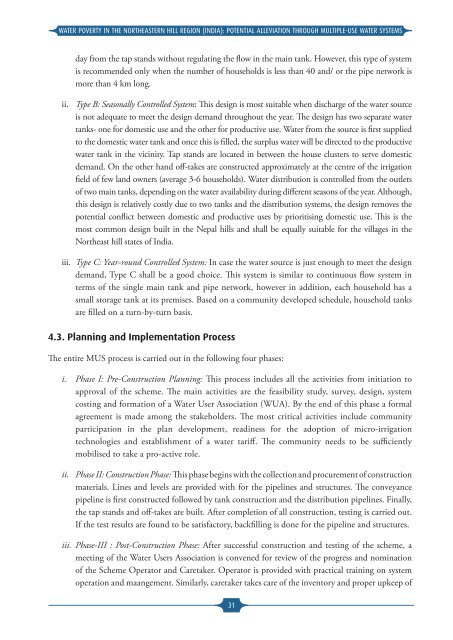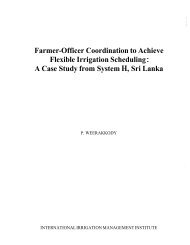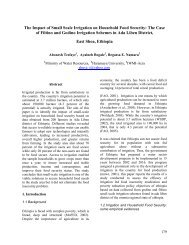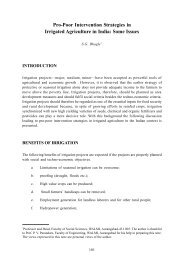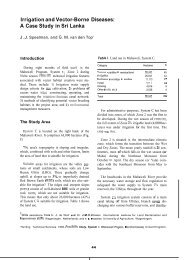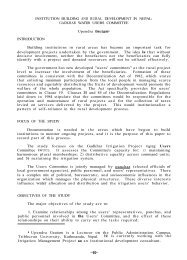WATER POVERTY IN THE NORTHEASTERN HILL REGION (INDIA)
WATER POVERTY IN THE NORTHEASTERN HILL REGION (INDIA)
WATER POVERTY IN THE NORTHEASTERN HILL REGION (INDIA)
Create successful ePaper yourself
Turn your PDF publications into a flip-book with our unique Google optimized e-Paper software.
<strong>WATER</strong> <strong>POVERTY</strong> <strong>IN</strong> <strong>THE</strong> NOR<strong>THE</strong>ASTERN <strong>HILL</strong> <strong>REGION</strong> (<strong>IN</strong>DIA): POTENTIAL ALLEVIATION THROUGH MULTIPLE-USE <strong>WATER</strong> SYSTEMSday from the tap stands without regulating the flow in the main tank. However, this type of systemis recommended only when the number of households is less than 40 and/ or the pipe network ismore than 4 km long.ii. Type B: Seasonally Controlled System: This design is most suitable when discharge of the water sourceis not adequate to meet the design demand throughout the year. The design has two separate watertanks- one for domestic use and the other for productive use. Water from the source is first suppliedto the domestic water tank and once this is filled, the surplus water will be directed to the productivewater tank in the vicinity. Tap stands are located in between the house clusters to serve domesticdemand. On the other hand off-takes are constructed approximately at the centre of the irrigationfield of few land owners (average 3-6 households). Water distribution is controlled from the outletsof two main tanks, depending on the water availability during different seasons of the year. Although,this design is relatively costly due to two tanks and the distribution systems, the design removes thepotential conflict between domestic and productive uses by prioritising domestic use. This is themost common design built in the Nepal hills and shall be equally suitable for the villages in theNortheast hill states of India.iii. Type C: Year-round Controlled System: In case the water source is just enough to meet the designdemand, Type C shall be a good choice. This system is similar to continuous flow system interms of the single main tank and pipe network, however in addition, each household has asmall storage tank at its premises. Based on a community developed schedule, household tanksare filled on a turn-by-turn basis.4.3. Planning and Implementation ProcessThe entire MUS process is carried out in the following four phases:i. Phase I: Pre-Construction Planning: This process includes all the activities from initiation toapproval of the scheme. The main activities are the feasibility study, survey, design, systemcosting and formation of a Water User Association (WUA). By the end of this phase a formalagreement is made among the stakeholders. The most critical activities include communityparticipation in the plan development, readiness for the adoption of micro-irrigationtechnologies and establishment of a water tariff. The community needs to be sufficientlymobilised to take a pro-active role.ii.Phase II: Construction Phase: This phase begins with the collection and procurement of constructionmaterials. Lines and levels are provided with for the pipelines and structures. The conveyancepipeline is first constructed followed by tank construction and the distribution pipelines. Finally,the tap stands and off-takes are built. After completion of all construction, testing is carried out.If the test results are found to be satisfactory, backfilling is done for the pipeline and structures.iii. Phase-III : Post-Construction Phase: After successful construction and testing of the scheme, ameeting of the Water Users Association is convened for review of the progress and nominationof the Scheme Operator and Caretaker. Operator is provided with practical training on systemoperation and maangement. Similarly, caretaker takes care of the inventory and proper upkeep of31


